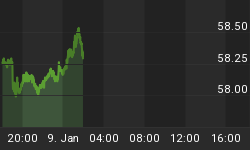
Three Tailwinds Could Converge For Bulls
- Central banks continue to print
- 13-year S&P 500 breakout
- The economy is still growing
We Can Accomplish More Working Together
The man sitting in the big chair at the European Central Bank (ECB) pledged to do "whatever it takes" to save the euro. Recent economic data from Europe has had a deflationary slant, which prompted the following tweet:

True to his word, Mario Draghi sent currency traders scrambling after this week's formal ECB policy statement. From Forbes:
While U.S. investors kept their eyes peeled for Twitter's first trade, European Central Bank President Mario Draghi shocked markets by cutting interest rates to fight deflation, as Eurozone prices fell to their lowest levels in four years. Draghi, who said they have tools in their "artillery" but aren't at the point where they will shoot the QE bazooka, made it clear risks to the outlook remain skewed to the downside, adding the decision to cut rates wasn't unanimous.

In a global economy still recovering from the biggest credit-induced over-consumption bubble of all time, no country wants a strong currency. The ECB announcement sent the U.S. dollar soaring higher, which put the Fed behind in the currency race to the bottom. On the cooperation front, if the ECB is worried about deflation, the Fed is worried about deflation. Signals this week continued to support the "taper later" case. From The Wall Street Journal:
The Federal Reserve believes U.S. unemployment is still too high and it remains committed to boosting job creation, Chairman Ben Bernanke said Friday. "There's an awful lot of slack in the labor market and a lot of young people living with their parents," Mr. Bernanke said at a research conference hosted by the International Monetary Fund. U.S. unemployment stood at 7.3% in October, near five-year lows, but many economists believe this measure understates the magnitude of the country's employment problems. These economists point to the fact that the number of people who are working is little changed since the country emerged from the recession and say the improvement in the unemployment rate is mainly the result of people giving up their job searches and exiting the labor force.
Term Probability Applies To All Market Forecasts
Regular readers know we are not big fans of forecasting since it brings bias and ego into the decision making picture. We prefer flexibility. If we tell you the S&P 500 is going to 1650, then we will review all new information through a "the market is going to 1650" lens. However, probabilistic forecasting is helpful from a planning perspective.
Breakouts Are Bullish, Right?
Technical analysis is the study of charts. As we have mentioned numerous times, if you understand that charts allow us to monitor how all investors around the globe (aggregate opinion) are interpreting the massive amounts of fundamental data, technical analysis takes on an economic "that makes sense to me" component that is often overlooked. Therefore, the expressions "what are the charts telling us" and "how are market participants interpreting the fundamentals" become interchangeable. The answers to those questions are outlined in this week's stock market outlook video.
One of the topics covered in the video above is consolidations and breakouts. Markets consolidate (move sideways/make little progress) when investors have mixed opinions about the state of the global economy. A breakout occurs when the logjam of uncertainty clears. A push to the upside tells us bullish economic conviction ultimately beat bearish economic conviction. The chart below shows a 13-year consolidation period in the S&P 500 that was followed by a bullish breakout.

Wild Card: The Economy
Central banks are hoping they can end their aggressive and unconventional policies. The analogy below from an October 28 article describes the relationship between injecting money into the global economy (QE process) and the economy:
Those of you who have experience with old-school charcoal grills know lighter fluid is used to prime the proverbial pump until the coals can take over. Quantitative easing (QE) is the Fed's lighter fluid for the economy. The hope is that money printing will help spark economic growth. Once economic growth picks up, the Fed can put its lighter fluid away. The problem is if the Fed stops pumping lighter fluid onto the economic coals, the present day fire may go out.

Friday's much anticipated monthly employment situation report may reduce some of the tossing and turning by Fed governors during sleepless nights. From The Washington Post:
The U.S. job market finally seems to be picking up -- but for a shrinking share of the population. The Labor Department reported Friday that the nation's economy added 204,000 jobs in October, defying analysts' expectations of weak results even as the federal government shutdown bumped up the unemployment rate to 7.3 percent. Businesses in retail, hospitality, manufacturing and health care expanded their payrolls significantly. Estimates of hiring for the previous two months were revised upward.
Investment Implications
As we outlined in detail on October 10, the sharp rally off the recent debt-ceiling-crisis low in stocks was telegraphed by the markets. The bullish attributes from October 10 have company; defensive assets, cyclical assets and observable bias toward inflation rather than deflation have all aligned with the "stocks could surprise on the upside" case, from a probability perspective. Consequently, as long as the market's pricing mechanism supports the risk-on allocation we began building when our market model gave us the bullish green light on October 10, we will continue to hold U.S. stocks (SPY) financials (XLF), energy (QQQ), technology (QQQ), foreign stocks (EFA), and a recently-reduced stake in emerging markets (EEM).
















